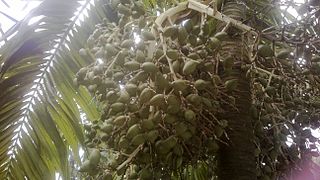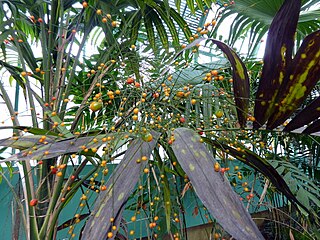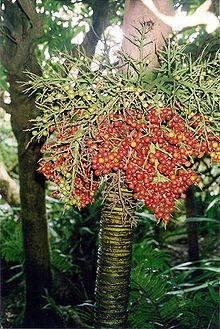
Allagoptera is a monoecious genus of flowering plant in the palm family found in South America consisting of 5 accepted species. Compared to other genera within the Cocoseae Allagoptera is described as particularly specialized. The genus name is a Greek combination of "change" and "feather", describing the full leaf; it was formerly named Diplothemium.
Barcella is a monotypic genus of flowering plant in the palm family found in the States of Amazonas and Roraima in northwestern Brazil. The only known species is Barcella odora which is used by the Brazilian peoples in construction and for various thatched goods.
Brassiophoenix is a monoecious genus of flowering plant in the palm family found in Papua New Guinea. Of the two similar species, one is more common in cultivation and was mistakenly identified as Brassiophoenix schumannii. In 1999, Zona and Estig showed that the commonly cultivated species was instead the type species Brassiophoenix drymophoeoides. The two species are distinguished by their separated geographical locations and minor differences in fruit form. The genus name is a combination of the surname Brass, honoring the first collector L.J. Brass, and Phoenix, another palm genus.

Calyptrocalyx is a monoecious genus of flowering plant in the palm family found in Papua New Guinea and the nearby Maluku Islands. Ranging from small to large, the palms in this genus are increasingly found in cultivation owing largely to their purple, red, and orange colored, new foliage. At least 26 species have been described while others, known only by local names, have not yet received a taxonomic account. Palms formerly classified within Paralinospadix have been incorporated into this genus. It is named from 2 Greek words meaning 'covered' and 'calyx'.

Actinorhytis is a monotypic genus of flowering plant in the palm family found in Oceania and southeast Asia. The lone species, Actinorhytis calapparia is a rain forest inhabitant and has very large fruit. The genus name is from two Greek words meaning 'ray' and 'fold' which describe the endosperm of the seed.
Clinosperma bractealis is a species of palm tree in the palm family

Dictyocaryum is a monoecious genus of flowering plant in the palm family found in South America. It is closely related to the genus Iriartea; they are commonly called araque or palma real. As many as eleven species have been described but this number is reduced to three in most current accounts. The genus name translates from two Greek words meaning "net" and "nut", describing the thick network of raphe fibers around the seed.

Dictyosperma is a monotypic genus of flowering plant in the palm family found in the Mascarene Islands in the Indian Ocean. The sole species, Dictyosperma album, is widely cultivated in the tropics but has been farmed to near extinction in its native habitat. It is commonly called princess palm or hurricane palm, the latter owing to its ability to withstand strong winds by easily shedding leaves. It is closely related to, and resembles, palms in the genus Archontophoenix. The genus is named from two Greek words meaning "net" and "seed" and the epithet is Latin for "white", the common color of the crownshaft at the top of the trunk.
Cyphokentia macrostachya is a species of palm endemic to New Caledonia.

Laccospadix is a monotypic genus of flowering plant in the palm endemic to Queensland. Only one species is known, Laccospadix australasicus, commonly called Atherton palm or Queensland kentia. The two Greek words from which it is named translate to "reservoir" and "spadix".
Laccosperma is a clustering genus of flowering plant in the family palm found in tropical Africa. Poorly studied and rarely cultivated, they are closely related to the genus Eremospatha and with it form a tribe in the Calameae characterized by dyads of hermaphrodite flowers. The genus name combines the Greek words for "reservoir" and "seed".
Leopoldinia is a mostly monoecious genus of flowering plant in the palm family from northern South America, where they are known as jará palm or pissava palm. The two known species are commercially important, especially L. piassaba, which yields sustenance and construction material. The genus is named for Maria Leopoldina, archduchess of Austria, and Brazilian empress.
Lepidocaryum is a monotypic genus of flowering plant in the palm family from South America where the lone species, Lepidocaryum tenue, is commonly called poktamui. Nine species names have been published, but palm taxonomists currently agree that just one variable species includes them all. The most reduced member of the Lepidocaryeae, it is similar in appearance to three closely related genera, Mauritia, Mauritiella, and Lytocaryum. The genus name combines the Greek words for "scale" and "nut" and the species epithet is Latin for "thin".

Lytocaryum is a monoecious genus of flowering plant in the palm family endemic to Brazil where 4 species are known. Palms once classified as Microcoelum are herein included; the genus is closely related to Syagrus, from which it is differentiated only by abundant tomentum, strongly versatile anthers, and slight epicarp, mesocarp, and endocarp differences. The name is Greek for "loose" and "nut".

Mauritiella is a dioecious genus of flowering plant in the palm family found in South America where it is commonly called buriti. It is named after the similar and closely related genus Mauritia.

Myrialepis is a monotypic genus of flowering plant in the palm family, the single species, Myrialepis paradoxa, native to Southeast Asia. The genus name is a combination of the Greek words meaning "innumerable" and "scale", a description of the fruit, and the epithet is Latin for "paradox".
Oncocalamus is a monoecious genus of flowering plants in the palm family found in western Africa. The genus is the lone member of the Oncocalaminae; once placed with the vegetatively similar Eremospatha and Laccosperma in the Ancistrophyllinae, it is now isolated based on their unusual flowers and arrangement. Such a placement argues for a long and complex evolutionary process in the Calamoideae with heavy extinction rates. The Greek genus name combines "horn" and "capsule".

Oraniopsis is a monotypic genus of flowering plant in the palm family from Queensland, Australia, where the only known species, Oraniopsis appendiculata, grows in mountainous rain forest. Dioecious and extremely slow growing, the name means "similar to Orania" and the Latin epithet translates to "appendaged".

Ptychococcus is a monoecious genus of flowering plant in the palm family from New Guinea and the Solomon Islands. They are closely related to Ptychosperma, only differentiated by the seed shape and endocarp type. The name is a combination of the Greek for "fold" and the Latin for "berry".

Synechanthus is a monoecious genus of flowering plant in the palm family found in Mexico, Central and South America. Commonly called bola, palmilla, or jelly bean palm, they are closely related to members of Chamaedorea, only distinguished by their flower and fruit form. The Greek genus name is a combination of "united" and "flower".













